Publication
BIOCATALYSIS AND AGRICULTURAL BIOTECHNOLOGY
Biocatalysis and Agricultural Biotechnology
Official journal of the International Society of Biocatalysis and Agricultural Biotechnology (ISBAB)
In 2009, ISBAB Board decided to launch its official journal and asked Ching Hou to search for a publisher. Publisher Anthony Newman of Elsevier agreed to publish ISBAB journal, however suggested to start a trial run in its existing journal New Biotechnology as “ISBAB Special Issues” for two years. Ching Hou organized a team of editors and served as Editor-in-Chief for this task. The first issue of “ISBAB Special Issues” was published in October 2009. After successfully published “ISBAB Special Issues” for two years, Elsevier agreed to publish the official journal of ISBAB. Ching Hou and his editors team launched the new ISBAB Official Journal “Biocatalysis and Agricultural Biotechnology (BAB)” in January of 2012.
Biocatalysis and Agricultural Biotechnology is the official journal of the International Society of Biocatalysis and Agricultural Biotechnology (ISBAB). The journal publishes high quality articles especially in the science and technology of biocatalysis, bioprocesses, agricultural biotechnology, biomedical biotechnology, and, if appropriate, from other related areas of biotechnology. The journal will publish peer-reviewed basic and applied research papers, authoritative reviews, and feature articles.
The scope of the journal encompasses the research, industrial, and commercial aspects of biotechnology, including the areas of: biocatalysis; bioprocesses; food and agriculture; genetic engineering; molecular biology; healthcare and pharmaceuticals; biofuels; genomics; nanotechnology; environment and biodiversity; and bioremediation.
Types of papers published are: Full-length original research papers; Short communications; Review articles; Letters to the Editor.
Submit your research now!!
https://www.journals.elsevier.com/biocatalysis-and-agricultural-biotechnology
Editor-in-Chief
Ching T. Hou
U.S. Department of Agriculture (USDA), Agricultural Research Service (ARS), Peoria, IL, USA
Associate Editor-in-Chief
Yung-Sheng Huang
National Chung Hsing University, Taichung, Taiwan
Official journal of the International Society of Biocatalysis and Agricultural Biotechnology (ISBAB)
In 2009, ISBAB Board decided to launch its official journal and asked Ching Hou to search for a publisher. Publisher Anthony Newman of Elsevier agreed to publish ISBAB journal, however suggested to start a trial run in its existing journal New Biotechnology as “ISBAB Special Issues” for two years. Ching Hou organized a team of editors and served as Editor-in-Chief for this task. The first issue of “ISBAB Special Issues” was published in October 2009. After successfully published “ISBAB Special Issues” for two years, Elsevier agreed to publish the official journal of ISBAB. Ching Hou and his editors team launched the new ISBAB Official Journal “Biocatalysis and Agricultural Biotechnology (BAB)” in January of 2012.
Biocatalysis and Agricultural Biotechnology is the official journal of the International Society of Biocatalysis and Agricultural Biotechnology (ISBAB). The journal publishes high quality articles especially in the science and technology of biocatalysis, bioprocesses, agricultural biotechnology, biomedical biotechnology, and, if appropriate, from other related areas of biotechnology. The journal will publish peer-reviewed basic and applied research papers, authoritative reviews, and feature articles.
The scope of the journal encompasses the research, industrial, and commercial aspects of biotechnology, including the areas of: biocatalysis; bioprocesses; food and agriculture; genetic engineering; molecular biology; healthcare and pharmaceuticals; biofuels; genomics; nanotechnology; environment and biodiversity; and bioremediation.
Types of papers published are: Full-length original research papers; Short communications; Review articles; Letters to the Editor.
Submit your research now!!
https://www.journals.elsevier.com/biocatalysis-and-agricultural-biotechnology
Editor-in-Chief
Ching T. Hou
U.S. Department of Agriculture (USDA), Agricultural Research Service (ARS), Peoria, IL, USA
Associate Editor-in-Chief
Yung-Sheng Huang
National Chung Hsing University, Taichung, Taiwan
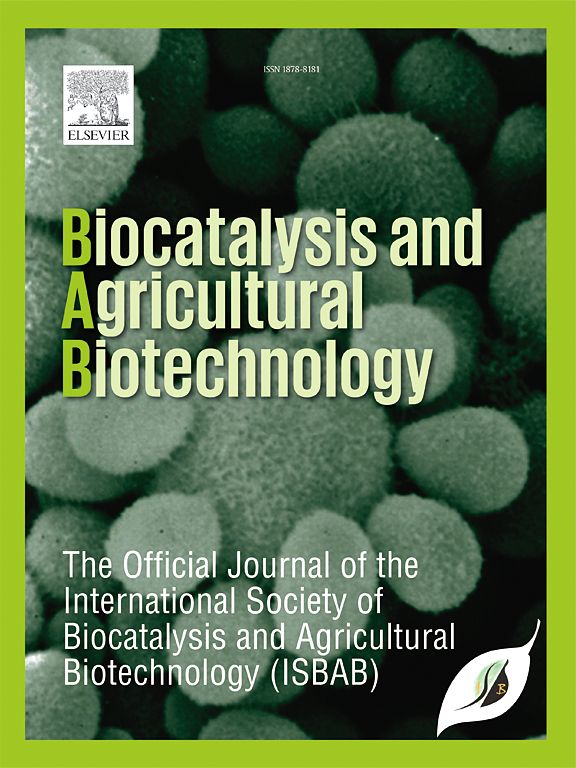
attached file
New Biotechnology-ISBAB Special Issues
New Biotechnology-ISBAB Special Issues
In 2009, ISBAB Board decided to launch its official journal and asked Ching Hou to search for a publisher. Publisher Anthony Newman of Elsevier agreed to publish ISBAB journal, however suggested to start a trial run in its existing journal New Biotechnology as “ISBAB Special Issues” for two years. Ching Hou organized a team of editors and served as Editor-in-Chief for this task. The first issue of “ISBAB Special Issues” was published in October 2009. After successfully published “ISBAB Special Issues” for two years, Elsevier agreed to publish the official journal of ISBAB. Ching Hou and his editors team launched the new ISBAB Official Journal “Biocatalysis and Agricultural Biotechnology (BAB)” in January of 2012.
Special issue on Biocatalysis and Agricultural Biotechnology: number 1
Volume 26, Issues 1-2 (2009)
Special issue on Biocatalysis and Agricultural Biotechnology: number 2
Volume 26, Issues 3-4 (2009)
Special issue on Biocatalysis and Agricultural Biotechnology: number 3
Volume 27, Issue 1 (2010)
Special issue on Biocatalysis and Agricultural Biotechnology: number 4
Volume 27, Issue 4 (2010)
Special issues on Biocatalysis and Agricultural Biotechnology: number 5
Volume 28, Issue 1 (2011)
Special issues on Biocatalysis and Agricultural Biotechnology: number 6
Volume 28, Issue 2 (2011)
Special issues on Biocatalysis and Agricultural Biotechnology: number 7-9
Volume 28, Issue 6 (2011)
In 2009, ISBAB Board decided to launch its official journal and asked Ching Hou to search for a publisher. Publisher Anthony Newman of Elsevier agreed to publish ISBAB journal, however suggested to start a trial run in its existing journal New Biotechnology as “ISBAB Special Issues” for two years. Ching Hou organized a team of editors and served as Editor-in-Chief for this task. The first issue of “ISBAB Special Issues” was published in October 2009. After successfully published “ISBAB Special Issues” for two years, Elsevier agreed to publish the official journal of ISBAB. Ching Hou and his editors team launched the new ISBAB Official Journal “Biocatalysis and Agricultural Biotechnology (BAB)” in January of 2012.
Special issue on Biocatalysis and Agricultural Biotechnology: number 1
Volume 26, Issues 1-2 (2009)
Special issue on Biocatalysis and Agricultural Biotechnology: number 2
Volume 26, Issues 3-4 (2009)
Special issue on Biocatalysis and Agricultural Biotechnology: number 3
Volume 27, Issue 1 (2010)
Special issue on Biocatalysis and Agricultural Biotechnology: number 4
Volume 27, Issue 4 (2010)
Special issues on Biocatalysis and Agricultural Biotechnology: number 5
Volume 28, Issue 1 (2011)
Special issues on Biocatalysis and Agricultural Biotechnology: number 6
Volume 28, Issue 2 (2011)
Special issues on Biocatalysis and Agricultural Biotechnology: number 7-9
Volume 28, Issue 6 (2011)
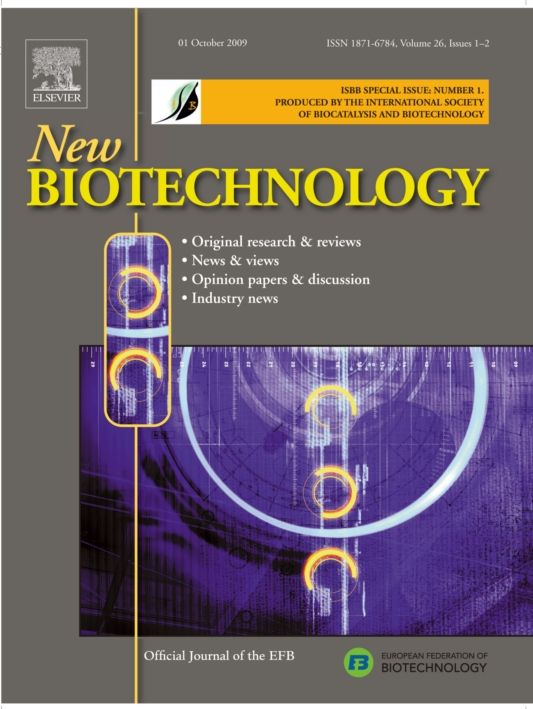
attached file
Biocatalysis and Biomolecular Engineering, John Wiley & Sons, 2010
Biocatalysis and Biomolecular Engineering
Ching T. Hou (Editor), Jei-Fu Shaw (Editor)
ISBN: 978-0-470-48759-4
An expert overview of new technologies guiding the construction of a sustainable society.
This compendium of important insights from sixty distinguished international scholars looks at the significant advances in progressive environmental technology—especially the molecular engineering used on plants, animals, and microorganisms—as the game changer in the high-stakes race to reverse earth-damaging practices.
Biocatalysis and Biomolecular Engineering covers subject matter on the latest developments in eco-friendly and energy-saving manufacturing processes with the emphasis on agricultural technology and bio-based products. Focusing its study on remedies that show promise in curing food and energy ills, this book examines groundbreaking work in various fields, such as nutraceuticals, genetic engineering of agricultural products, and bioenergy. Biocatalysis and Biomolecular Engineering:
•Can be used as a reference by teachers, graduate students, and industrial scientists who conduct research in bioscience and biotechnology
•Serves as the first book to bring together fundamentals and leading-edge technologies for the development of bio-based industrial products through biocatalysis; for example, it discusses the preparation of biofunctional micro- and nanoparticles
•Contains chapters by international experts from academia, industry, and government research institutes
Biocatalysis and Biomolecular Engineering builds a cohesive, well thought out case for nurturing new discoveries in eco-technology by inviting critical discussion on devising viable solutions to sustaining the future wellness of humankind.
Ching T. Hou (Editor), Jei-Fu Shaw (Editor)
ISBN: 978-0-470-48759-4
An expert overview of new technologies guiding the construction of a sustainable society.
This compendium of important insights from sixty distinguished international scholars looks at the significant advances in progressive environmental technology—especially the molecular engineering used on plants, animals, and microorganisms—as the game changer in the high-stakes race to reverse earth-damaging practices.
Biocatalysis and Biomolecular Engineering covers subject matter on the latest developments in eco-friendly and energy-saving manufacturing processes with the emphasis on agricultural technology and bio-based products. Focusing its study on remedies that show promise in curing food and energy ills, this book examines groundbreaking work in various fields, such as nutraceuticals, genetic engineering of agricultural products, and bioenergy. Biocatalysis and Biomolecular Engineering:
•Can be used as a reference by teachers, graduate students, and industrial scientists who conduct research in bioscience and biotechnology
•Serves as the first book to bring together fundamentals and leading-edge technologies for the development of bio-based industrial products through biocatalysis; for example, it discusses the preparation of biofunctional micro- and nanoparticles
•Contains chapters by international experts from academia, industry, and government research institutes
Biocatalysis and Biomolecular Engineering builds a cohesive, well thought out case for nurturing new discoveries in eco-technology by inviting critical discussion on devising viable solutions to sustaining the future wellness of humankind.
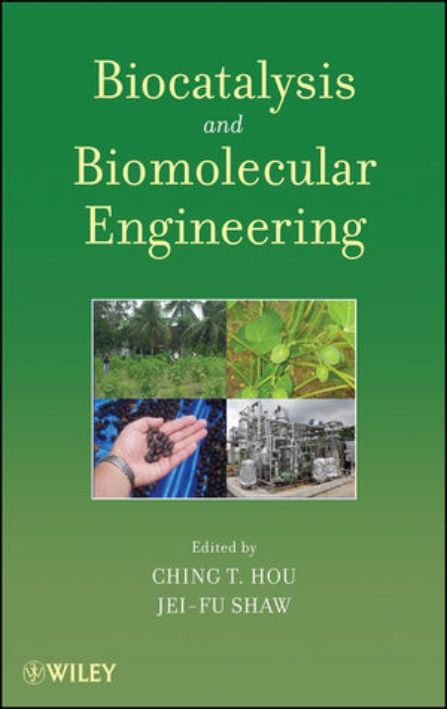
attached file
Biocatalysis and Agricultural Biotechnology, CRC press, 2009
Biocatalysis and Agricultural Biotechnology
Ching T. Hou, United States Department of Agriculture, Peoria, Illinois, USA
Jei-Fu Shaw, National Chung Hsing University, Taichung, Taiwan
Features
Explores cutting-edge research on both biocatalysis and agricultural biotechnology. Discusses the improvement of agronomic and microbial traits.
Contains an array of graphs and illustrations to bolster understanding of discussed concepts.
Summary
Worldwide energy and food crises are spotlighting the importance of bio-based products – an area many are calling on for solutions to these shortages. Biocatalysis and Agricultural Biotechnology encapsulates the cutting-edge advances in the field with contributions from more than 50 international experts comprising sectors of academia, industry, and government research institutes, a virtual Who’s Who among biocatalysis scientists.
Created Under the Editorial Guidance of Leading Biotechnology Experts
With the aid of numerous graphs and illustrations, this authoritative reference documents such important advances as:
This comprehensive text also explores a variety of bio-based industrial products, including:
Providing in-depth reviews of this ancient field and its modern-day advances, Biocatalysis and Agricultural Biotechnology is an invaluable lab reference for teachers, graduate students, and industrial scientists conducting research in the biosciences.
Ching T. Hou, United States Department of Agriculture, Peoria, Illinois, USA
Jei-Fu Shaw, National Chung Hsing University, Taichung, Taiwan
Features
Explores cutting-edge research on both biocatalysis and agricultural biotechnology. Discusses the improvement of agronomic and microbial traits.
Contains an array of graphs and illustrations to bolster understanding of discussed concepts.
Summary
Worldwide energy and food crises are spotlighting the importance of bio-based products – an area many are calling on for solutions to these shortages. Biocatalysis and Agricultural Biotechnology encapsulates the cutting-edge advances in the field with contributions from more than 50 international experts comprising sectors of academia, industry, and government research institutes, a virtual Who’s Who among biocatalysis scientists.
Created Under the Editorial Guidance of Leading Biotechnology Experts
With the aid of numerous graphs and illustrations, this authoritative reference documents such important advances as:
- Cloning and characterization of Kennedy pathway acyltransferases
- Engineering of plants for industrial uses
- New approaches from acquired tolerance to the biotic and abiotic stress of economically important crops
This comprehensive text also explores a variety of bio-based industrial products, including:
- The modification of enzyme character through gene manipulation
- The biocatalytic synthesis of chiral intermediates for drug development
- The use of Omega-3 phospholipid nano capsules as effective forms for transporting immune response modifiers
Providing in-depth reviews of this ancient field and its modern-day advances, Biocatalysis and Agricultural Biotechnology is an invaluable lab reference for teachers, graduate students, and industrial scientists conducting research in the biosciences.
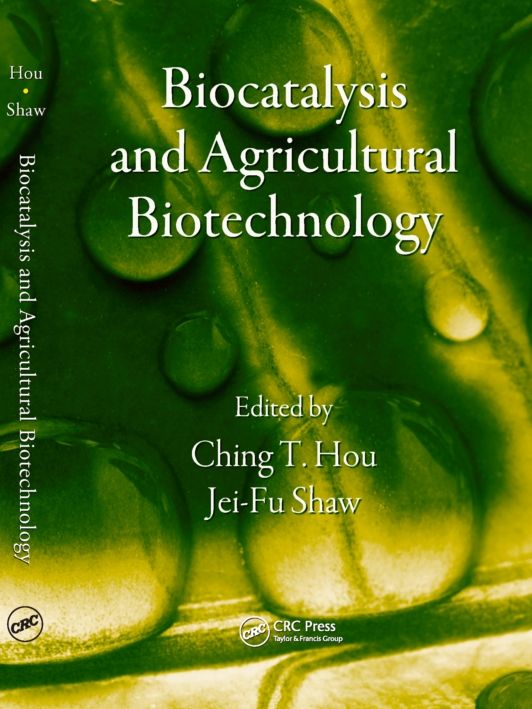
attached file
Biocatalysis and Bioenergy, John Wiley & Sons, 2008
Biocatalysis and Bioenergy
C. T. Hou, Jei-Fu Shaw
ISBN: 978-0-470-13404-7
An up-to-date overview of diverse findings and accomplishments in biocatalysis and bioenergy.
With the high price of petroleum and researchers worldwide seeking new means of producing energy, this comprehensive book on biocatalysis for bioenergy and biofuel applications is very timely. It combines information on state-of-the-art advances and in-depth reviews of the latest achievements in biocatalysis and bioenergy, emphasizing biodiesel, bioethanol, and industrial products. The advantages of biocatalysis include high specificity, efficiency, energy conservation, and pollution reduction. Biocatalysis and Bioenergy details advances in the field, with:
Contributions from leading experts worldwide who share their research and findings. The prospect of using biocatalysis for the production of energy has great potential due to its cost-effectiveness, the fact that it does not require a limited resource such as oil, and its potential universality of application and use globally. This is the definitive reference for biochemists and biochemical engineers, bioprocess and bioenergy scientists, physical and oil chemists (oleochemists), microbiologists, industrial microbiologists, molecular biologists, metabolic engineers working in biocatalysis, bioethanol, and biodiesel fuels, DOE scientists working on renewable energy, and other professionals in related fields.
C. T. Hou, Jei-Fu Shaw
ISBN: 978-0-470-13404-7
An up-to-date overview of diverse findings and accomplishments in biocatalysis and bioenergy.
With the high price of petroleum and researchers worldwide seeking new means of producing energy, this comprehensive book on biocatalysis for bioenergy and biofuel applications is very timely. It combines information on state-of-the-art advances and in-depth reviews of the latest achievements in biocatalysis and bioenergy, emphasizing biodiesel, bioethanol, and industrial products. The advantages of biocatalysis include high specificity, efficiency, energy conservation, and pollution reduction. Biocatalysis and Bioenergy details advances in the field, with:
- Three primary sections, covering biodiesel research, bioethanol, and industrial products
- Information on enzyme catalysis, biotransformation, bioconversion, fermentation, genetic engineering, and product recovery
Contributions from leading experts worldwide who share their research and findings. The prospect of using biocatalysis for the production of energy has great potential due to its cost-effectiveness, the fact that it does not require a limited resource such as oil, and its potential universality of application and use globally. This is the definitive reference for biochemists and biochemical engineers, bioprocess and bioenergy scientists, physical and oil chemists (oleochemists), microbiologists, industrial microbiologists, molecular biologists, metabolic engineers working in biocatalysis, bioethanol, and biodiesel fuels, DOE scientists working on renewable energy, and other professionals in related fields.
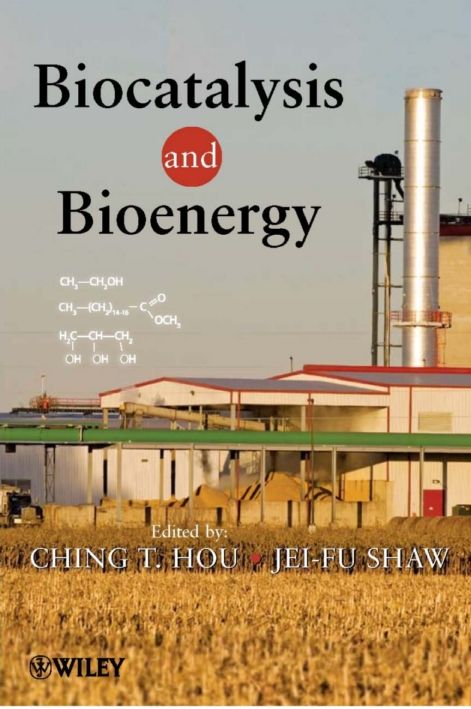
attached file
Biocatalysis and Biotechnology for Functional Foods and Industrial Products, CRC & AOCS, 2006
Biocatalysis and Biotechnology for Functional Foods and Industrial Products
Ching T. Hou United States Department of Agriculture, Peoria, Illinois, USA
Jei-Fu Shaw National Chung Hsing University, Taichung, TAIWAN
CRC Press
Features
Biocatalysis and biotechnology are rapidly advancing areas of research with the significant advantages of high specificity, efficiency, energy conservation, and pollution reduction. With applications in industrial processes and the huge world nutraceutical and functional food market, of which the US alone is responsible for more than $100 billion per year, this is clearly a domain that needs a comprehensive reference for the current knowledge in the field.
Biocatalysis and Biotechnology for Functional Foods and Industrial Products is an in-depth collection of reviews of the current advances in biocatalysis and biotechnology as presented at the International Symposium on Biocatalysis and Biotechnology held at the National Chung Hsing University, Taichung, Taiwan in October 2005. With an emphasis on functional foods and industrial products, this is the most current compendium available. Internationally recognized scientists from US, Japan, Korea, Iceland, Germany, and Taiwan share their valuable research results on topics within the general definition of biocatalysis and biotechnology. Covering the latest applications for enzyme catalysis, biotransformation, bioconversion, fermentation, genetic engineering, and product recovery, this book outlines one-step catalytic reactions as well as many sequential reaction steps involved in production. Divided into two sections, the first present’s cutting edge information on functional food research including health food, nutritional supplements, and nutraceuticals. Chapters include enzymatic fractionation, chemoenzymatic synthesis, and novel biofunctions for functional nutrients. The second section is devoted to industrial applications such as the biotransformation of aliphatic hydrocarbons, biodegradable industrial lubricants, and the stabilization of living microbial biological control agents for insecticides.
Providing a comprehensive review of the modern development of biocatalysis and biotechnology, Biocatalysis and Biotechnology for Functional Foods and Industrial Products is a valuable reference for researchers and scientists as well as an indispensable introduction of the state-of-the-science for newcomers to the field.
Ching T. Hou United States Department of Agriculture, Peoria, Illinois, USA
Jei-Fu Shaw National Chung Hsing University, Taichung, TAIWAN
CRC Press
Features
Biocatalysis and biotechnology are rapidly advancing areas of research with the significant advantages of high specificity, efficiency, energy conservation, and pollution reduction. With applications in industrial processes and the huge world nutraceutical and functional food market, of which the US alone is responsible for more than $100 billion per year, this is clearly a domain that needs a comprehensive reference for the current knowledge in the field.
Biocatalysis and Biotechnology for Functional Foods and Industrial Products is an in-depth collection of reviews of the current advances in biocatalysis and biotechnology as presented at the International Symposium on Biocatalysis and Biotechnology held at the National Chung Hsing University, Taichung, Taiwan in October 2005. With an emphasis on functional foods and industrial products, this is the most current compendium available. Internationally recognized scientists from US, Japan, Korea, Iceland, Germany, and Taiwan share their valuable research results on topics within the general definition of biocatalysis and biotechnology. Covering the latest applications for enzyme catalysis, biotransformation, bioconversion, fermentation, genetic engineering, and product recovery, this book outlines one-step catalytic reactions as well as many sequential reaction steps involved in production. Divided into two sections, the first present’s cutting edge information on functional food research including health food, nutritional supplements, and nutraceuticals. Chapters include enzymatic fractionation, chemoenzymatic synthesis, and novel biofunctions for functional nutrients. The second section is devoted to industrial applications such as the biotransformation of aliphatic hydrocarbons, biodegradable industrial lubricants, and the stabilization of living microbial biological control agents for insecticides.
Providing a comprehensive review of the modern development of biocatalysis and biotechnology, Biocatalysis and Biotechnology for Functional Foods and Industrial Products is a valuable reference for researchers and scientists as well as an indispensable introduction of the state-of-the-science for newcomers to the field.
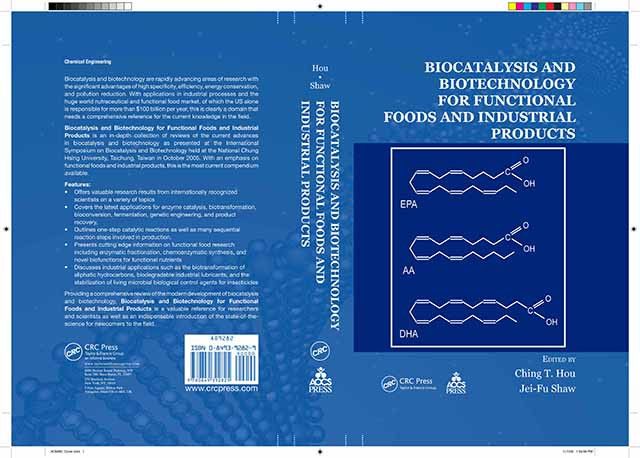
attached file
Handbook of Industrial Biocatalysis, CRC Press, 2005.
Handbook of Industrial Biocatalysis
Edited by Ching T. Hou
Discusses virtually every aspect of biocatalysis from international experts most actively researching the field.
Features
Edited by Ching T. Hou
Discusses virtually every aspect of biocatalysis from international experts most actively researching the field.
Features
- Explores every stage of biocatalysis, including enzyme catalysis, biotransformation, bioconversion, fermentation, and biotechnology
- Highlights the production of chiral intermediates that exhibit anticancer, antiviral, and other inhibiting behaviors
- Covers the production of industrial chemicals using principles of green chemistry
- Includes comprehensive chapters replete with illustrations and examples
- Contains references throughout the text that provide direction for further study
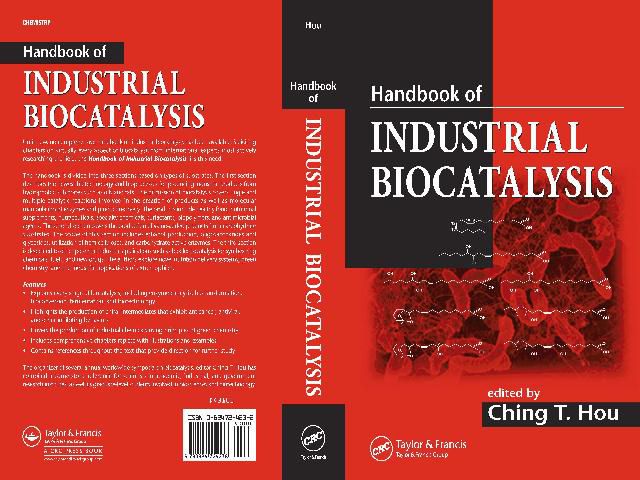
attached file
